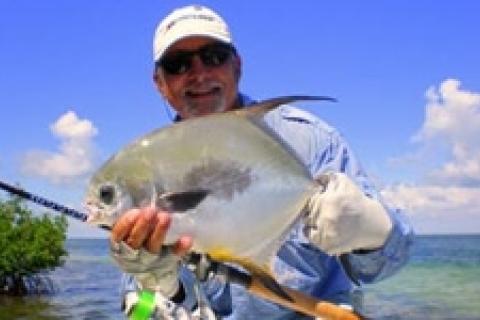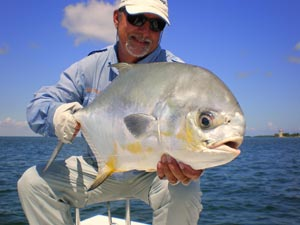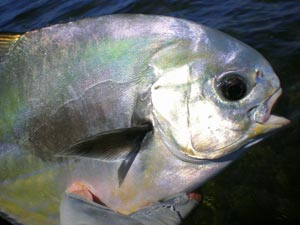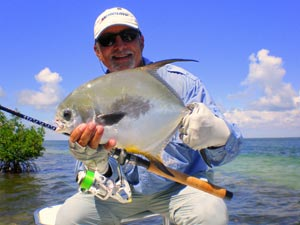
Though permit on the flats can be found outside the United States in such places as Roatan, Cuba, parts of the Bahamas, the Caribbean coast of Mexico's Quintana Roo province and certainly Belize, the stretch of Florida's shallows from Miami to Key West to the Marquesas invariably has the largest size permit on the planet. I've called this magic portion of Florida the Permit Coast. The Sunshine State is the only place to catch permit on the flats in the USA.
 |
| The wind scuff on the surface allowed a closer cast to this permit. |
What anglers should find exciting is that they never have to leave the country in order to capture and release this shallow water prize that can top fifty pounds. There is a plentitude of excellent guides in Miami ready to guide anglers to the permit fishing barely 30 minutes from the downtown area. And the big bonus is that these permit average fifteen to eighteen pounds, which again gives Florida the nod for having the largest average size of permit on the planet as well.
Important Facts and Distinctions
Most all marine anglers are aware of the mythical status of the permit as well as it's place amongst the Big Three of the flats, the other two being bonefish and tarpon. Because of its size range, permit, as well as tarpon, generally are best found in flats waters starting at three-feet deep. Bonefish, which are smaller, can be found in waters as shallow as a foot or less.
One of the reasons that permit are so spooky in shallow water is that the flats are not the natural home to them the way they are to bonefish. Permit often spend their time offshore over reefs and wrecks. When they head inshore to shallows only three to five feet deep, they feel very spooky and vulnerable to predation.
Permit fan out over flats waters to prowl on their favorite food source, which are live crabs. Occasionally, they eat other crunchy items like small lobsters. My ex-I.G.F.A. world record permit — 23 pounds, 15 ounces on 4-pound line — had its belly full of black sea urchin.
Yet the key to cracking the code on the shallow water permit is to understand its relationship to crabs. Indeed, permit on the flats are likely to be found in the vicinity of rock piles, channel markers, sandy potholes and channels. All of these areas either hold crabs on solid structure or via seaweed and current aggregations between the flats on the water surface. Of course, permit can be found on the "crowns" of flats hunting for food as well.
Anglers will sight permit either in the cruising mode or by "tailing" if the water is shallow enough for their caudal fin to break the surface as they tip down to feed on the bottom. Although anglers mystify permit sightings, in actuality they are fairly easy to see swimming. Often, they manifest themselves as a dark-backed silhouette that swims with a wagging tailbeat.
How it's Done
Because of the three to five foot water depths on the flats, it's essential to pursue permit in a shallow draft vessel with silent or very quiet propulsion. There are three vessels that are used. The first and most common is a poled flats boat. The second most common method is by using a somewhat larger bay boat powered by an electric motor. My friend "Mr. Permit" Captain Tom Rowland of Key West uses his bay boat for permit with consistent success. The last method is by using a kayak powered by paddle. Now that kayaks are built with better stand-up ability, this latter method will grow more popular in areas where permit are a "paddler's distance" away from the starting point.
Permit Fishing Tackle
The proper fishing tackle setup for permit has become well established and falls between choosing either spinning tackle or fly tackle. Spinning tackle generally entails monofilament or braided line of ten or twelve pound breaking strength. Braid has a smaller diameter than "mono" for the same breaking strength, and therefore offers theoretically further casting potential — all other factors being equal. Braid will require a 20-pound fluorocarbon leader, which will neutralize the running line's visibility. Clear monofilament is basically invisible to permit, but should have a leader fashioned by a double line formed by a Bimini Twist or Spider Hitch knot.
 |
| The large eyes of the permit gives this gamester excellent vision. |
Always bear in mind that longer rods offer theoretically longer casts. I only use eight and one half to nine-foot long spinning rods instead of the stock seven-foot models all too commonly supplied by guide boats. I've never been "outcasted" by one of these latter models. The longer spinner generally can be bought in the "steelhead" section of most tackle company's selection. These rods are often sold as two-piece models and therefore wind up as easy-to-take travel items.
The most universal bait on spinning tackle is a live silver dollar-sized live blue crab. The bait is fixed to a super-sharp 2/0 J-hook by slowly and gently working the point through and out of one of the points of the crab's shell. Be sure to check the point's sharpness once the hookup has been achieved. After that, the live crab is left in the water with the angler's rod pointing down until they are ready to cast it when they sight a fish.
The other option on spinning tackle is to use artificial lures. This choice will increase the difficulty of catching a permit considerably. Permit have extremely good eyesight and quickly recognize when an offering does not either look or behave like their natural foods that they have been consuming their entire lives. The track record of the soft plastic crab look-alike lures has been disappointing compared to the classic hackle skimmer head jig. Although it is obvious that this diamond-shaped jig does not look all that much like a crab, there is something about its action through the water column that permit find enticing — but more on the presentation style later.
Fly fishing on the flats has grown in popularity in the last fifteen years. While it is not particularly hard to catch a bonefish or tarpon "on the fly," it is quite difficult to catch a permit this way. Even though fly casters have created some flies that look like crabs, they simply still do not look or behave "on the strip" like the real thing. Catching a permit — particularly the big Florida specimens — on fly is considered by many knowledgeable anglers to be a lifetime achievement on the flats. Parenthetically, permit in deeper water around the wrecks and shrimp boats take a fly more quickly and are less of a challenge.
Presentation and Moment of Truth
 |
| This permit was spotted feeding along the sandy strip. |
The two major ways that permit manifest themselves on the flats will create one of the guidelines for the presentation. As stated before, these are the cruising and tailing modes. The second factor that shapes the presentation is the comparative calmness or roughness of the water on the flats.
Presenting a live crab, lure or even fly to a cruising permit means casting to a moving target. Logically, if the angler wants the presentation to be at the eye level of the cruising fish, the cast must "lead" the fish enough for it to have sunk to the proper depth by the time the fish should be seeing the offering. The angler's "lead" is determined by the depth of the water as well as the depth of the swimming permit in the water column. Generally, cruising permit will be found midway in the water column.
Hopefully, the offering has landed quietly and is sinking on a perfect intercept course in front of the permit. When fishing a live crab, there is no need to do anything but let the fish inhale the crab and when the line comes tight, smartly, but not-too-forcefully, strike it. When using a lure or fly on cruising permit, there are two schools of thought after the fish has clearly seen the presentation and is closing in. One approach is to let the lure or fly drop to the bottom and let the permit pin and suck in the offering. The "take" of the fish will be signaled by a "ping" in the running line. The second approach is to keep the lure or fly moving away from the permit to elicit a predatory attack. My position is that the angler should watch the behavior of each fish to determine what he or she'll do with their fly or lure.
The second manifestation of the permit is tailing. It is important to understand that a tailing permit is a busy, feeding fish. It is already tipped down in a feeding mode and the goal of the angler is to get the attention of the permit by ringing the dinner bell — but ever so gently, since no life form has their food jump on their head or attack them! Once again, a live crab "fishes itself," but a lure or fly does not. Cast your lure or fly closer to a tailing permit and govern its action by the response of the tailing fish once it has seen your offering.
Lastly, the rule of water conditions and permit is that calmer water necessitates a longer lead on the presentation as well as smaller baits, lines and lures for subtlety of splash on the landing of the cast.
- 10880 views

